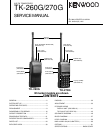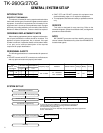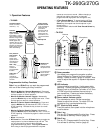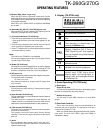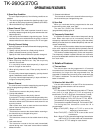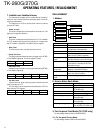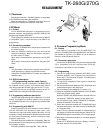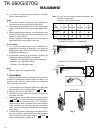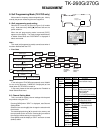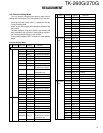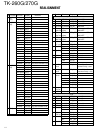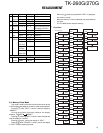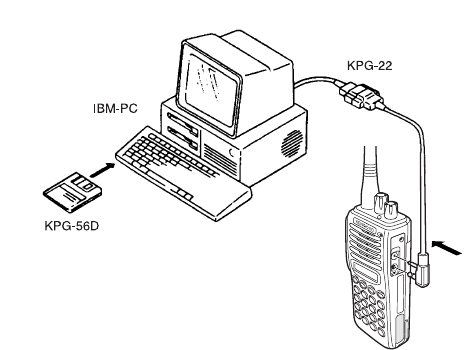
TK-260G/270G
9
6. Firmware Programming Mode
6-1. Preface
Flash memory is mounted on the TK-260G/270G. This
allows the TK-260G/270G to be upgraded when new features
are released in the future. (For details on how to obtain the
firmware, contact Customer Service.)
6-2. Connection procedure
Connect the TK-260G/270G to the personal computer (IBM
PC or compatible) with the interface cable (KPG-22).
(Connection is the same as in the PC Mode.)
6-3. Programming
1. Start up the programming software (KPG-56D), select
"firmware program" in the "Program" item, and press the
Return key on your personal computer. This starts up the
firmware programmer.
2. The top screen is displayed. Press any key to advance to
the next screen.
3. Set the communications speed (normally, 57600 bps) and
communications port in the Setup item.
4. Set the firmware to be updated by File select (=F1).
5. Hold down the [LAMP] and [MON] switches on the TK-260G/
270G, and press the power switch.
When the [LAMP] and [MON] switches are held down for
two seconds, "PROG576" appears on the display and
the LED lights orange. When "PROG576" is displayed,
release the switches (TK-270G only).
6. Check the connection between the TK-260G/270G and
the personal computer, and make sure the TK-260G/270G
is in Program mode.
7. Press F10 on the personal computer. A window opens on
the display to indicate the writing progress. When the TK-
260G/270G begins to receive data, the LED lights green.
8. When data is received successfully, a checksum appears
on the display.
(Since the TK-260G does not have a display, check the
checksum with the FPU (KPG-56D).)
Fig. 1
REALIGNMENT
4. Checksum
Executing this function, "TUNING" appears on the display
of TK-270G while calculating the checksum .
When the calculation is completed, the display returns to
normal and PC displays the checksum of the radio.
5.PC Mode
5-1. Preface
The TK-260G/270G transceiver is programmed using a
personal computer, a programming interface (KPG-22) and
programming software (KPG-56D).
The programming software can be used with an IBM PC
or compatible. Figure 1 shows the setup of an IBM PC for
programming.
5-2. Connection procedure
1. Connect the TK-260G/270G to the personal computer with
the interface cable.
2. When the POWER is switched on, user mode can be
entered immediately. When the PC sends a command,
the radio enters PC mode.
When data is transmitted from transceiver, the red LED
blinks.
When data is received by the transceiver, the green LED
blinks.
Notes:
• The data stored in the personal computer must match the
model type when it is written into the flash memory.
• Change the TK-260G/270G to PC mode, then attach the
interface cable.
5-3. KPG-22 description
(PC programming interface cable: Option)
The KPG-22 is required to interface the TK-260G/270G to
the computer. It has a circuit in its D-subconnector (25-pin)
case that converts the RS-232C logic level to the TTL level.
The KPG-22 connects the SP/MIC connector of the TK-
260G/270G to the computers RS-232C serial port.
5-4. Programming software description
The KPG-56D programming disk is supplied in 3-1/2” disk
format. The software on this disk allows a user to program
the TK-260G/270G radios via a programming interface cable
(KPG-22).
5-5. Programming with IBM PC
If data is transferred to the transceiver from an IBM PC
with the KPG-56D, the destination data (basic radio
information) for each set can be modified. Normally, it is not
necessary to modify the destination data because their values
are determined automatically when the frequency range
(frequency type) is set.
The values should be modified only if necessary. Data can
be programmed into the flash memory in RS-232C format via
the universal connector.
KPG-56D installation manual part No. : B62-1153-XX



